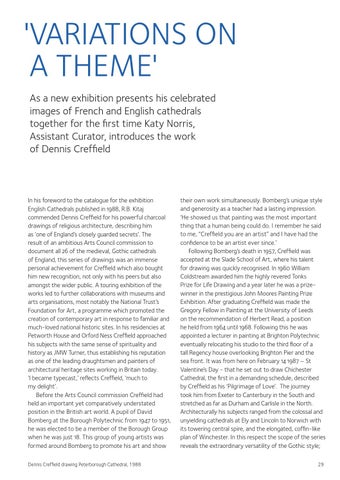'VARIATIONS ON A THEME'
As a new exhibition presents his celebrated images of French and English cathedrals together for the first time Katy Norris, Assistant Curator, introduces the work of Dennis Creffield
In his foreword to the catalogue for the exhibition English Cathedrals published in 1988, R.B. Kitaj commended Dennis Creffield for his powerful charcoal drawings of religious architecture, describing him as ‘one of England’s closely guarded secrets’. The result of an ambitious Arts Council commission to document all 26 of the medieval, Gothic cathedrals of England, this series of drawings was an immense personal achievement for Creffield which also bought him new recognition, not only with his peers but also amongst the wider public. A touring exhibition of the works led to further collaborations with museums and arts organisations, most notably the National Trust’s Foundation for Art, a programme which promoted the creation of contemporary art in response to familiar and much-loved national historic sites. In his residencies at Petworth House and Orford Ness Creffield approached his subjects with the same sense of spirituality and history as JMW Turner, thus establishing his reputation as one of the leading draughtsmen and painters of architectural heritage sites working in Britain today. ‘I became typecast,’ reflects Creffield, ‘much to my delight’. Before the Arts Council commission Creffield had held an important yet comparatively understated position in the British art world. A pupil of David Bomberg at the Borough Polytechnic from 1947 to 1951, he was elected to be a member of the Borough Group when he was just 18. This group of young artists was formed around Bomberg to promote his art and show Dennis Creffield drawing Peterborough Cathedral, 1988
their own work simultaneously. Bomberg’s unique style and generosity as a teacher had a lasting impression. ‘He showed us that painting was the most important thing that a human being could do. I remember he said to me, “Creffield you are an artist” and I have had the confidence to be an artist ever since.’ Following Bomberg’s death in 1957, Creffield was accepted at the Slade School of Art, where his talent for drawing was quickly recognised. In 1960 William Coldstream awarded him the highly revered Tonks Prize for Life Drawing and a year later he was a prizewinner in the prestigious John Moores Painting Prize Exhibition. After graduating Creffield was made the Gregory Fellow in Painting at the University of Leeds on the recommendation of Herbert Read, a position he held from 1964 until 1968. Following this he was appointed a lecturer in painting at Brighton Polytechnic eventually relocating his studio to the third floor of a tall Regency house overlooking Brighton Pier and the sea front. It was from here on February 14 1987 – St Valentine’s Day - that he set out to draw Chichester Cathedral, the first in a demanding schedule, described by Creffield as his ‘Pilgrimage of Love’. The journey took him from Exeter to Canterbury in the South and stretched as far as Durham and Carlisle in the North. Architecturally his subjects ranged from the colossal and unyielding cathedrals at Ely and Lincoln to Norwich with its towering central spire, and the elongated, coffin-like plan of Winchester. In this respect the scope of the series reveals the extraordinary versatility of the Gothic style; 29
